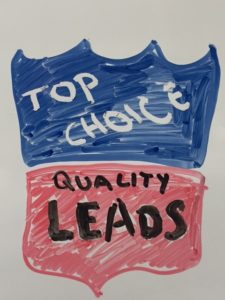5 Simple Tips for Determining Lead Quality
 When most people think about developing leads, quantity is often the focus. Hiring more sales reps and front-loading seems to be the default practice of most organizations—whether they’ve actually thought about the process or not. While an increase in sales leads is always a goal, marketing and sales teams should really be focusing on the quality of leads, not just quantity.
When most people think about developing leads, quantity is often the focus. Hiring more sales reps and front-loading seems to be the default practice of most organizations—whether they’ve actually thought about the process or not. While an increase in sales leads is always a goal, marketing and sales teams should really be focusing on the quality of leads, not just quantity.
Aaron always tells our clients that even if you have a crummy sales process, if you have an excellent system of generating qualified leads, you’re going to do well. It may seem like a lot of work to qualify leads, but it ends up saving you and your sales team a lot of valuable time. Plus, you’ll see an increase in converted leads.
What qualifiers should you use for ranking leads?
Two ways of measuring lead quality: analyze a prospect’s closing potential and revenue potential. Closing potential is how easily the lead will convert into an actual sale. Revenue potential is how much money that prospect could generate over a lifetime or a fixed period of time. How to determine this can be tricky. Just like figuring out which crops are worth your time to grow, qualifying leads will help you determine which to pursue.
1. Be Picky: Don’t Pursue Every Lead. Who’s your ideal customer profile (ICP)? What are some descriptors? What are their needs? Once you identify who your ideal customer is, only pursue leads that fit that description. Being picky will help your team focus on prospects that match your organization’s sweet spot and strategy.
2. Pay Attention: Nurture Your Leads. Because your leads are all at various stages in the buying process, ensure that there’s content that speaks to each level. One way of nurturing your leads is by analyzing the content prospects engaged with. Did they download a white paper about a certain topic or sign up for a webinar? Use these indicators to give you insight on where they are in the sales funnel and target content to them that speaks to that stage.
3. Focus on the Right Things: Track Conversion to Customer Rate. How are leads performing? Are they converting into paying customers? An offer with the best lead-to-opportunity conversion rate won’t always yield the best opportunity-to-customer conversion rate. See which offers are working and double down on that type of content to generate better qualified leads.
4. Work Smarter: Outsource. Employ third-party companies to help identify the habits and pains of your ideal customers. Outbound specialists can generate super-targeted lists of prospects for your team to target. They can also help you increase low email response rates by continually optimizing your email messaging.
5. Go Old School: Ask the Right Questions. Distinguish good leads the old-fashioned way: by asking prospects the right questions (and getting the right answers). This method obviously requires more time than the others since you’ll have to reach out to every lead to build a profile; be selective about which companies you and your team spend time on the phone with.
While marketing and sales teams are often graded on the number of leads they generate, organizations clearly also need to take into account the quality of the leads. When it comes to evaluating your leads, determine the measure by which to sort and rank so you can better determine with whom to follow up. By cultivating the good leads and weeding out the bad, your team will soon see the benefits of prioritizing quality over quantity.
Read more: Never Use These 7 Words In Your Emails.
Need help getting good quality leads in your pipeline? We can help! – Book a free discovery call